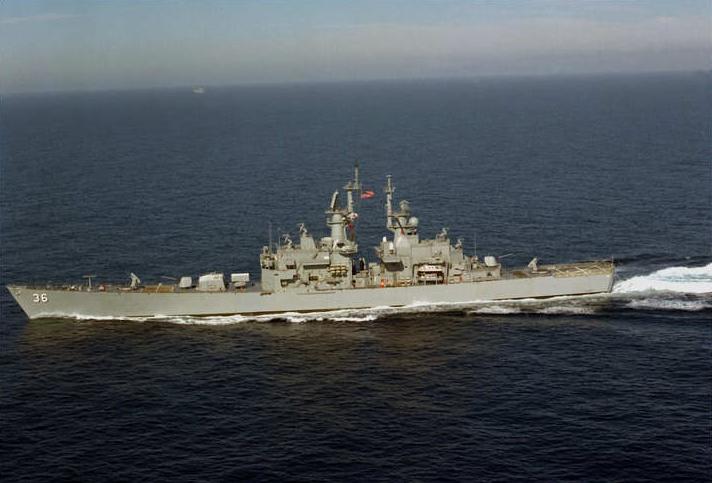CRUZADORES DE ATAQUE - CLASSE VIRGÍNIA
Enviado: Seg Mar 27, 2006 8:33 am
Strike Cruiser (CSGN)
Cruzadores Classe Virgínia

O CNN 38 USS Virgínia
The Navy originally planned to procure 11 ships of the Virginia class, in combination with CGN's of earlier classes, would have provided each of the projected CVN's with four nuclear powered escort vessels.
However, after four units of the Virginia class had been laid down, further orders were suspended while consideration was given to a Strike Cruiser (CSGN) concept. In 1974, the Navy proposed a program for a nuclear powered strike cruiser (CSGN).
During the Defense Systems Acquisition Review Council (DSARC) review, the Navy was asked to provide options for retrofit of the Aegis radar (based on a phased array proof of concept study conducted by JJMA) and to examine alternatives, both nuclear and conventional, considering both quantitative and qualitative factors.

CGN 37 US South Carolina
In June 1975 the Deputy Secretary of Defense (DEPSECDEF) directed the development of the gas turbine powered Aegis Destroyer (DDG 47), which was subsequently redesignated the CG 47 Ticonderoga class of Aegis cruisers.
The FY 1977 program was proposed as the first step of a sustained effort to assure that the United States, along with its allies, can maintain maritime defense, deterrence, and freedom of the seas. Congress failed to authorize $1.7 billion requested for new ship programs that were needed to strengthen US maritime capabilities.

In particular, they have denied funds for the lead ships for two production programs —- the nuclear strike cruiser and the conventionally powered AEGIS destroyer -— and for four modern frigates.
In 1976, the Senate Armed Services Committee completely deleted a Navy request for the nuclear-powered strike cruiser, while the House Armed Services Committee cut the Navy cruise-missile program by 40 percent.


__________________
Reclassificação levada a cabo pela US Navy aos diversos tipos de navios após 1975:
Até 30 de Junho de 1975
Attack Carrier (CVA/CVAN)
Cruiser (CG/CLG)
Destroyer (DD/DDG)
Ocean Escort (DE/DEG)
Após 20 de Junho de 1975
Multimission Carrier (CV/CVN)
Cruiser (CG)
Frigate (DL/DLG) --
Destroyer (DD/DDG)
Frigate (FF/FFG)
Patrol Frigate (PF) --
A última alteração deu-se a 1 de Janeiro de 1980, quando os "destroieres" Ticonderoga (DDG) passaram a ser denominados cruzadores (CG).
__________
http://www.navsource.org/
http://www.wikipedia.com
http://www.globalsecurity.org/military/systems/ship
Cruzadores Classe Virgínia

O CNN 38 USS Virgínia
The Navy originally planned to procure 11 ships of the Virginia class, in combination with CGN's of earlier classes, would have provided each of the projected CVN's with four nuclear powered escort vessels.
However, after four units of the Virginia class had been laid down, further orders were suspended while consideration was given to a Strike Cruiser (CSGN) concept. In 1974, the Navy proposed a program for a nuclear powered strike cruiser (CSGN).
During the Defense Systems Acquisition Review Council (DSARC) review, the Navy was asked to provide options for retrofit of the Aegis radar (based on a phased array proof of concept study conducted by JJMA) and to examine alternatives, both nuclear and conventional, considering both quantitative and qualitative factors.

CGN 37 US South Carolina
In June 1975 the Deputy Secretary of Defense (DEPSECDEF) directed the development of the gas turbine powered Aegis Destroyer (DDG 47), which was subsequently redesignated the CG 47 Ticonderoga class of Aegis cruisers.
The FY 1977 program was proposed as the first step of a sustained effort to assure that the United States, along with its allies, can maintain maritime defense, deterrence, and freedom of the seas. Congress failed to authorize $1.7 billion requested for new ship programs that were needed to strengthen US maritime capabilities.

In particular, they have denied funds for the lead ships for two production programs —- the nuclear strike cruiser and the conventionally powered AEGIS destroyer -— and for four modern frigates.
In 1976, the Senate Armed Services Committee completely deleted a Navy request for the nuclear-powered strike cruiser, while the House Armed Services Committee cut the Navy cruise-missile program by 40 percent.

CGN 38 USS Virgínia:
Laid down: 19 August 1972
Launched: 14 December 1974
Commissioned: 11 September 1974
Decommissioned: 10 November 1994
Fate: Scrapped
Struck: 10 November 1994
General Characteristics
Displacement: 11,000 tons
Length: 585 feet
Beam: 63 feet
Draft: 31 feet
Propulsion: 60,000 SHP; 2 G.E. Reactors (D2G), Geared Turbines, 2 screws
Speed: 30 knots
Range:
Complement: 500
Armament:
2 Standard SAM 1x2, (80 Missiles) 2 x 5"/54RF, ASROC (24 Missiles) 4 x12.75" TT.

__________________
Reclassificação levada a cabo pela US Navy aos diversos tipos de navios após 1975:
Até 30 de Junho de 1975
Attack Carrier (CVA/CVAN)
Cruiser (CG/CLG)
Destroyer (DD/DDG)
Ocean Escort (DE/DEG)
Após 20 de Junho de 1975
Multimission Carrier (CV/CVN)
Cruiser (CG)
Frigate (DL/DLG) --
Destroyer (DD/DDG)
Frigate (FF/FFG)
Patrol Frigate (PF) --
A última alteração deu-se a 1 de Janeiro de 1980, quando os "destroieres" Ticonderoga (DDG) passaram a ser denominados cruzadores (CG).
__________
http://www.navsource.org/
http://www.wikipedia.com
http://www.globalsecurity.org/military/systems/ship





